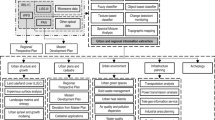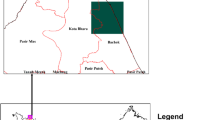Abstract
Surface landmine and minefield detection from airborne imagery is a difficult problem. As part of the minefield detection process, anomaly detection is performed to identify potential landmines in individual airborne images. Post-processing is performed on the initial landmines identified to reduce the number of false alarms, referred to as false alarm mitigation. In this research, a circular harmonics transform image processing approach (the CHT method) and a constant false alarm rate technique (the RX approach) are investigated for surface landmine detection and false alarm mitigation in medium wave infrared (MWIR) image data. The false alarm mitigation approach integrates the CHT and RX methods to identify candidate landmine locations with one technique at a given false alarm rate and applies the other technique to confirm landmine locations and eliminate potential false alarms. Individual detector and false alarm mitigation experimental results are presented for 31 daytime and 43 nighttime MWIR images containing 76 and 142 landmines, respectively. At a 0.9 desired probability of landmine detection, experimental results show that false alarm mitigation reduces the false alarm rate by as much as 84.3% and 13.7% for daytime and nighttime images, respectively, maintaining the probability of detection at 0.85 and 0.90, respectively.











Similar content being viewed by others
References
Haskett HT, Donzelli TP (2001) Minefield performance for LAMD using AMBER broadband/multiband MWIR imagery. Proc SPIE Conf Detect Remed Tech Mines Mine Target VI 4394:258–274
Bertsche KA, Huegle H (1997) Material requirements for airborne minefield detection system. Proc SPIE Int Soc Opt Eng 3079:487–497
Williams JW, Tee Howard S, Poulter MA (2001) Image processing and classification for the UK remote minefield detection system infrared polarimetric camera. Proc SPIE Conf Detect Remed Tech Mines Mine Targ VI 4394:139–152
Bishop PK, Crisp GN, Smith MJ (1999) Remote minefield detection. Proc SPIE Int Soc Opt Eng 3710(2):1130–1138
Lareau AG (1991) Flight performance of an airborne minefield detection and reconnaissance system. Photogam Eng Remot Sens 57(2):173–178
Stetson SP, Witherspoon NH, Holloway Jr JH, Suiter HR, Crosby, Hilton FJ, McCarley R (2000) COBRA ATD minefield detection results for the Joint countermine ACTD demonstrations. In: Proc SPIE Int Soc Opt Eng 4038(2):1268–1279
Agarwal S, Sriram P, Palit PP, Mitchell OR (2001) Algorithms for IR imagery-based airborne landmine and minefield detection. Proc SPIE Conf Detect Remed Tech Mines Mine Targ IV 4394:284–295
Maksymonko G, Breiter K (1997) ASTAMIDS minefield detection performance at Aberdeen proving ground test site. Proc SPIE 3079:726–737
Poulter MA, Tee HS (2001) Remote minefield detection system (REMIDS): a UK programme for airborne minefield detection. In: Proc Int Geosci Remot Sens Symp (IGARSS) 1:243–245
Muise RR, Wright JA, Holmes QA (1996) Coastal mine detection using the COBRA multispectral sensor. Proc SPIE Int Soc Opt Eng 2765:15–24
Haskett HT, Reago DA, Rupp RR (2001) Detectability of buried mines in 3–5 μm and 8–12 μm regions for various soils using hyperspectral signatures. Proc SPIE Conf Detect Remed Tech Mines Mine Targ VI 4394:296–309
Reed IS, Yu X (1990) Adaptive multi-band CFAR detection of an optical pattern with unknown spectral distribution. IEEE Trans Acoust Speech Sig Process 38(10):1760–1770
Liao W-J, Chen D-H, Baertlein BA (2001) Algorithms for detection of surface mines in multi-spectral IR and visible imagery. Proc SPIE Conf Detect Remed Tech Mines Mine Targ VI 4394:331–320
Yu X, Hoff LE, Reed IS, Chen AM, Stotts LB (1997) Automatic target detection and recognition in multiband imagery: a unified ML detection and estimation approach. IEEE Trans Imag Proc 6:143–156
Batman S, Goutsias J, Palki MB (2001) A GUI for automated detection of surface mines using iterated hybrid morphological filters. Proc SPIE Detect Remed Tech Mines Mine Targ VI 4394:334–345
Forssell G (2001) Surface landmine and trip wire detection using calibrated polarization measurements in the LWIR and SWIR. Proc SPIE Int Soc Opt Eng 4491:41–51
Gu I Y-H, Tjahjadi T (2002) Multiresolution feature detection using a family of isotropic bandpass filters. IEEE Trans Sys Man Cybern 32(4):443–454
Gu I Y-H, Tjahadi T (2002) Detecting and locating land mine fields from vehicle- and air-borne measured images. Patt Recog 35(12):323–337
Stanley RJ, Chamarthy P, Agarwal S, Mitchell OR (2002) Surface landmine detection in airborne images using the circular harmonics transform. Proc SPIE Conf Detect Remed Tech Mines Mine Targ VII 4742:150–159
Ashton EA, Schaum A (1998) Algorithm for the detection of sub-pixel targets in multispectral imagery. Photo Eng Remot Sens 64:723–731
Holmes QA, Schwartz CR, Seldin JH, Wright JA, Witter LW (1995) Adaptive multispectral CFAR detection of land mines. Proc SPIE Conf Detect Tech Mines Mine Targ 2496:421–432
Schweizer SM, Moura JMF (2000) Hyperspectral imagery: clutter adaptation in anomaly detection. IEEE Trans Info Theor 46:1855–1871
Rechtien RD, Mitchell OR. Airborne acoustic focusing system for landmine detection. Proc SPIE Int Soc Opt Eng 3710(1):223–230
Achal SB, McFee JE, Anger CD (1995) Identification of surface-laid mines by classification of compact airborne spectrographic imager (CASI) reflectance spectra. Proc SPIE Conf Detect Remed Tech Mines Mine Targ 2496:324–335
McFee JE, Ripley HT (1997) Detection of buried landmines using a casi hyperspectral imager. Proc SPIE Conf Detect Remed Tech Mines Mine Targ II 3079:738–749
Lundbert M, Svensson L, Gu IYH (2001) Infrared detection of buried land mines based on texture modeling. Proc SPIE Conf Detect Remed Tech Mines Mine Targ VI 4394:199–206
Banerji A, Goutsias J (1998) A morphological approach to automatic mine detection problems. IEEE Trans Aero Elect Sys 34:1085–1096
You J, Liang Z, Zeng GL (1999) A unified reconstruction framework for both parallel-beam and variable focal-length fan-beam collimators by a Cormack-type inversion of exponential radon transform. IEEE Tans Med Imag 18(1):59–65
Hawkins WG, Leichner PK (1994) An intrinsic 3D Wiener filter for the deconvolution of spatially collimator blur. IEEE Int Conf Imag Proc 2:163–167
Huang HS, Chang H-C (1990) Analysis of equilateral three-core fibers by circular harmonics expansion method. J Light Tech 8(6):945–952
Kudo H, Saito T (1988) Tomographic image reconstruction from hollow projections. Proc Int Conf Acoust Speech Sig Proc 2:1276–1279
Hansen EW (1981) Theory of circular harmonic image reconstruction. J Opt Soc Amer 71(3):304–308
Chiu C-F, Wu C-Y (1996) CMOS rotation-invariant pattern recognition system. In: Proceedings of the IEEE Asia Pacific Conference on Circuits and Systems, Beijing, China, 25–26 June 1996, pp 516–519
Chiu C-F, Wu C-Y (1997) The design of rotation-invariant pattern recognition using the silicon retina. IEEE J Sol-stat Circ 32(4):526–534
Hsu YN, Arsenault HH (1982) Rotation-invariant digital pattern recognition using circular harmonic expansion. Appl Opt 21(22):4012–4015
Budge SE (1990) A rotation invariant image pattern classifier. University of Michigan Press, Ann Arbor, MI
Serra J (1982) Image analysis and mathematical morphology. Academic Press, New York
Rosenfeld A, Pfaltz JL (1966) Sequential operations in digital picture processing. J Assoc Comp Mach 13:471–494
Gonzalez RC, Woods RE (1992) Digital image processing. Addison-Wesley, New York
Acknowledgements
The authors would like to acknowledge ARO for the funding for this research through the multi-university research initiative. We would also like to thank the countermine division of Night Vision Labs for making the data available for the abovementioned analysis.
Author information
Authors and Affiliations
Corresponding author
Rights and permissions
About this article
Cite this article
Stanley, R.J., Agarwal, S. & Somanchi, S. The impact of false alarm mitigation on surface landmine detection in MWIR imagery. Pattern Anal Applic 7, 26–39 (2004). https://doi.org/10.1007/s10044-003-0202-1
Received:
Accepted:
Published:
Issue Date:
DOI: https://doi.org/10.1007/s10044-003-0202-1




